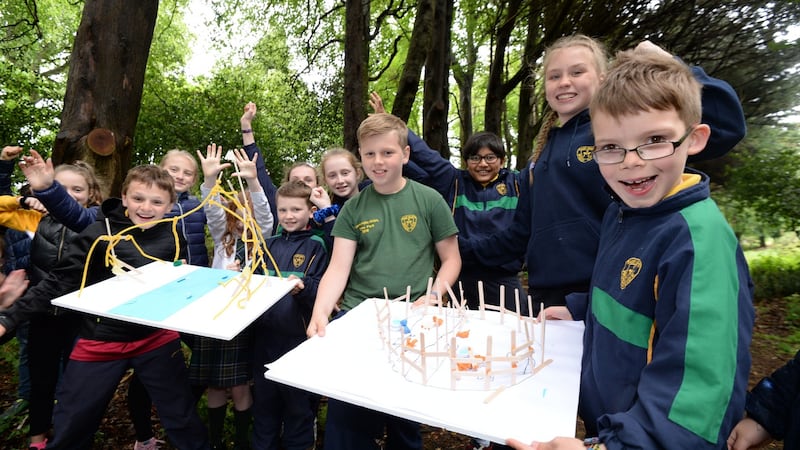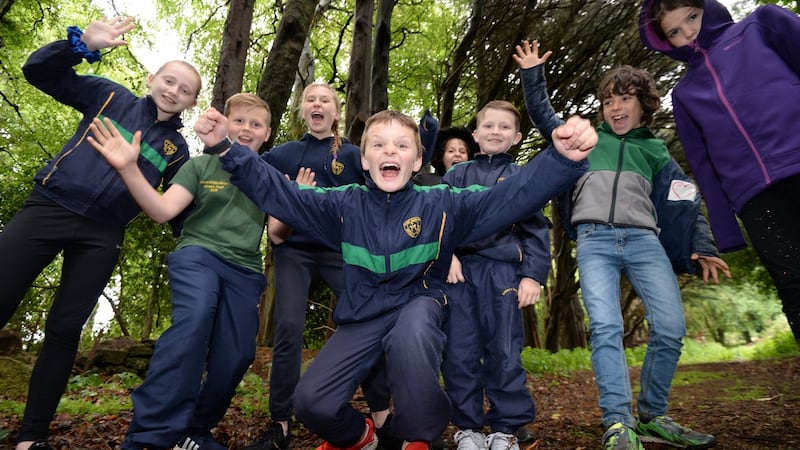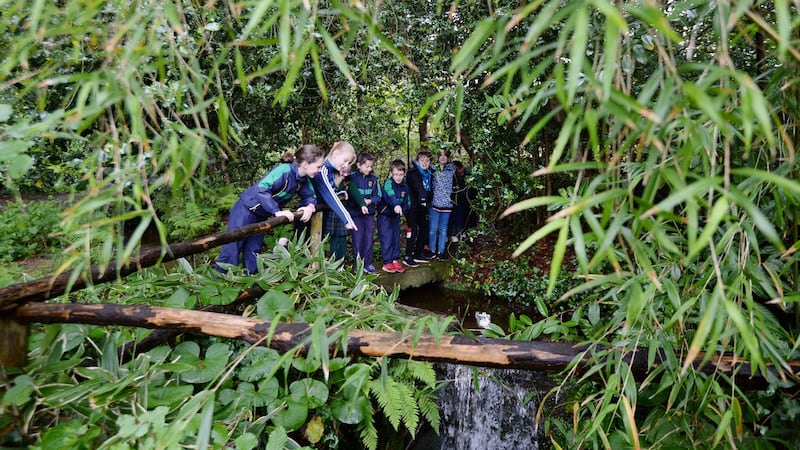Ask a child about their perfect playground and their answers may surprise you. Swings and roundabouts and slides are not as important as freedom: to experiment, take risks, become invisible, invent the landscape as they move through it.

That is what architect Shane Cotter discovered when he began consulting with children at St Mary's Woodside National School and Stepaside Educate Together on the design for a play space in the grounds of Fernhill Gardens in Stepaside, which has been recently opened as a public park by Dún Laoghaire-Rathdown County Council.
“We were blown away by how many ideas they had,” Cotter says on a rainy June morning in a wild forested area in Fernhill, where the first structures are about to be built. “We offered a couple of prompts, but what they came up with was so much better, and so much more craic.”
As it turns out, children know exactly how they would like to spend time in nature: building dens, climbing trees, and jumping rivers. It was Cotter’s job to help turn that imaginative fantasy into a physical reality.
The Fernhill Estate has a long and illustrious history. It is nestled at the foot of the Dublin mountains, and was established in 1832 by the Darley family, stonecutters who quarried granite from the local area. The family were committed horticulturalists, planting acres of acid-loving ericaceous plants, while allowing areas of woodland and wild meadow to grow freely.
Even on a rainy day it is a magical place. In the formal gardens pink and white petalled clouds of rhododendrons, camellias and magnolias are just coming into bloom, while in the uncultivated areas, towering ferns uncurl around your ears. A thick boundary of cypress trees and Scots pine provides a shelter belt from the wind, and from the higher points of the historic Broadwalk path you can just about see Dublin Bay.
The estate was sold for development in 2007 for more than €40 million, but was requisitioned by Nama when the economy crashed. Dún Laoghaire-Rathdown County Council took up ownership in 2015 for a 10th of the price, and committed to maintaining its precious wildness.
Leave no trace
As Ruairí Ó Dúlaing, chief of parks with DLR explains, the development of Fernhill is taking place under an innovative sustainability strategy, which includes plans for power generation (hydro, solar and wind), a leave-no-trace “no bin” policy, and a community garden, which is already operational, where local families are growing their own food.

At the front of the estate, a herd of cattle are seasonally employed to graze on a wild meadow, which has never been cut, to preserve biodiversity of the area. Currently, access to the estate is for pedestrians only. Although there are plans for a carpark to be built later this year, “we don’t want a carpark to be the first thing you experience about this special place,” Ó Dúlaing says.
“Our number one priority is to allow the site itself to be the major designer. Obviously we have an obligation for accessibility for all, but we also need to be sensitive to the environment in terms of how we provide that. Once you make something a public park, you change it for ever, so you need to make sure that it will be resilient enough to absorb a large amount of people. Our job is to welcome people, but we don’t want to ruin the magic. We need to protect what’s attracting them. We need to protect Fernhill for a future generation.”
It was with the future generation in mind that Ó Dúlaing had the idea to consult with local schoolchildren about the sort of playground they might enjoy using at Fernhill. Ó Dúlaing has been “building playgrounds for 25 years, but they have evolved into places that don’t really give children the opportunity to use their imagination, invent their own games or engage in rough and tumble”.

Using the estate’s unique landscape as a starting point, “we wanted to create a natural play environment that would engage with the environment around it”. Usually, Ó Dúlaing elaborates, pointing to a stately row of thick-trunked cypress trees, “we would think of taking those trees down to facilitate putting in a playground, but instead, based on ideas from the kids, they will be a central design feature of the play space”.
Expert consultants
With support from Creative Ireland, the council invited children from two local schools to bring their expertise to the development. After all, who knows better how to play than children?
Nine-year-old Hugo Fitzgerald-Selby is a pupil at St Mary’s Woodside National School. He loves “being high and going fast”, and his ideas centred on a zip-line that would cross a small stream at the back of the play space, which the children named “the hideaway”. Hanging the tight wire over the shallow water, he says, “is really exciting. There’s always a chance of you falling in.”
His schoolmate, Isabelle Keddy (11), is also a thrill seeker. Her design revolved around a clear perspex bridge and slide, "so you can see underneath when you are moving. I thought it would be scary; that you would be crossing hoping you won't drop into the water."
Ruby Stronge (9) from Stepaside Educate Together wanted to make sure “you don’t have to leave if it starts raining and you are having fun”. She designed an eco-powered retractable canopy that provides shelter in inclement weather.
Other elements of the design included accessibility ramps for wheelchair users and buggies, and a sheltered space for parents. As Cotter says, “they were really thoughtful and considerate and, without any prompting, central to all the discussion was how everybody should be able to enjoy it, not just children like them.”
Risk and adventure
All of these features will be included in the design when the playground is fully operational at the end of the year. As Ó Dúlaing explains, “there were certain parameters in terms of health and safety. So we assessed fall heights and surfaces as you would with any other playground. We had to find that sweet spot between risk and adventure.
“Ultimately, everything they wanted we managed to facilitate. We had to make that happen, otherwise it would be a pointless exercise. I wanted a treehouse,” he says for emphasis, “but they didn’t, so there will be no treehouse.”
Of course, there will be some elements familiar to seasoned playground users – monkey bars, swings, a fireman’s pole, and that zip-line – but Cotter concedes that the children’s design “has a vibrancy beyond a normal playground”. It will also be a continually evolving structure. “They suggested that we would bring stuff to the area that they can use to build their own structures. In that way it will never get boring, they said. And if it does, they will know what to do.”

A giant pile of logs sits upon the site already, ready to be repurposed as a den or a dam or a bridge. Children from all over Dublin are invited to do just that in a series of workshops taking place on Saturday at Fernhill, as part of Cruinniú na nÓg, the annual national day of play for young people. Some of the playground’s features will be in place, and adventurous users can contribute their own ideas to the space, which Cotter and his colleagues will take on board before the final phase of building begins.
CRUINNIÚ NA nÓG
This is the third year of Cruinniú na nÓg, a national day of creativity for children, which takes place at hundreds of venues throughout the country. Fernhill will be the centre of Dún Laoghaire-Rathdown County Council's celebrations this year, offering children an opportunity to participate in cultural activities as varied as den building, comic-book-making and instrument workshops. There are hundreds of similar events happening around the country. In Liberty Park in Dublin 2, local children are invited to collaborate with writer Nathan O'Donnell and photographer Louis Haugh in reimagining the public space. In Blackpool in Co Cork, Rebel Streets is inviting children to make their mark on public buildings in a series of street art interventions. In Manorhamilton in Co Leitrim, local schoolchildren have planned a street celebration that includes a music stage, where performances will be professionally recorded for posterity. In Kilkenny, teenagers have been collaborating with Barnstorm Theatre Company to create performances and a live installation about the effects of social media on their lives, while in Clara, Co Offaly, young people have created a piece of live music about the town, which will be played by the local town band.
cruinniu.creativeireland.gov.ie










